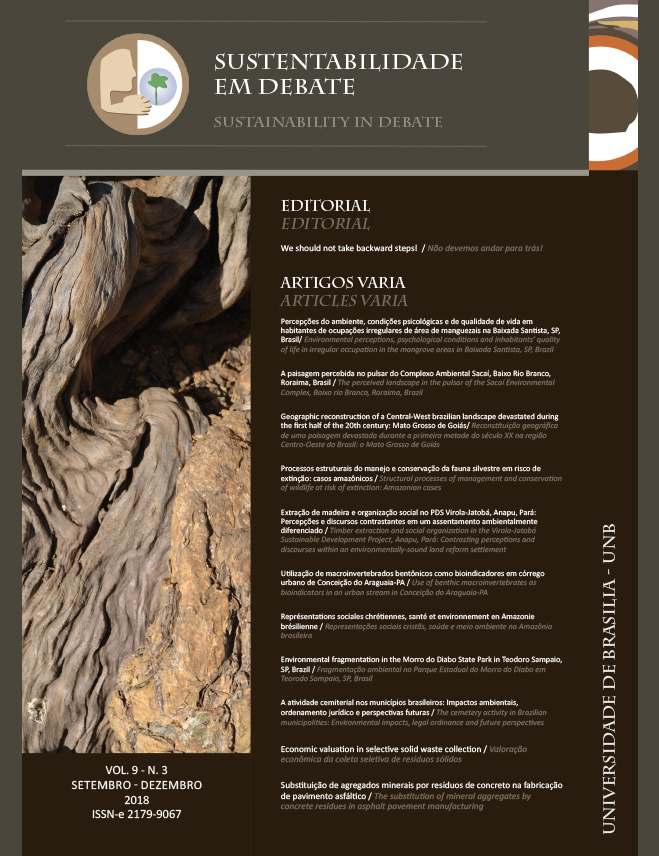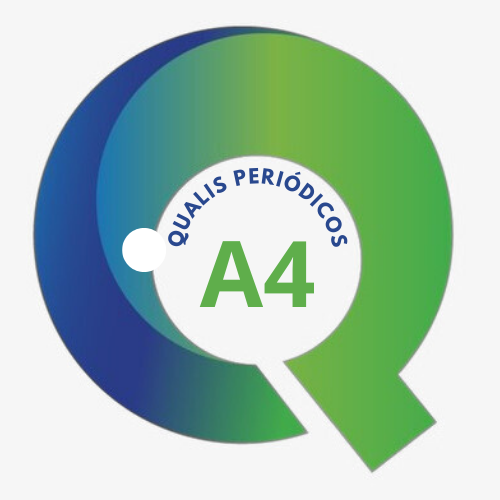A paisagem percebida no pulsar do Complexo Ambiental Sacaí, Baixo rio Branco, Roraima, Brasil
DOI :
https://doi.org/10.18472/SustDeb.v9n3.2018.18379Mots-clés :
Comunidades Ribeirinhas; Agroecossistemas; Autopoiese; Imaterialidade.Résumé
Os agroecossistemas amazônicos são parte de uma estrutura complexa, a Amazônia, e apresentam estruturas têmporo-espaciais diretamente relacionadas ao ambiente vivificado e ao saber imaterial dos agricultores. Este estudo teve por objetivo a compreensão do movimento de conservação da autopoiese da vida no Complexo Ambiental Sacaí, Caracaraí, Roraima, Brasil, a partir dos processos antitéticos de delineamento têmporo-espacial do pulso das águas, manifestos a partir das paisagens de seca e de cheia. O fluir do Complexo Ambiental Sacaí traz consigo temporalidade e espacialidade, as quais podem ser reveladas a partir das diversas visões de mundo sobre as unidades de paisagem. Apesar de se mostrarem de forma concreta, essas unidades de paisagem somente são possíveis de serem acessadas desde o caminho imaterial, resultado do vivificado. Foram utilizados como instrumentos de coleta de dados, entrevista com roteiro prévio, mapa de recursos naturais e reuniões espontâneas de validação nas varandas (Revv).
Références
BALÉE, W. The research program of historical ecology. Cadernos do Lepaarq, v. 14, p. 180-212, 2017. Disponível em: <https://periodicos.ufpel.edu.br/ojs2/index.php/lepaarq/article/download/12675/7943>. Acesso em: 5 abr. 2018.
BOULHOSA, M. B. M.; MENDES, A. C. Mapeamento da paisagem na área de influência do Porto de Vila do Conde, Barcarena, Pará. In: CONGRESSO BRASILEIRO DA ABEQUA, 2007, Belém. Anais... Belém, 2007.
CARLOS, A. F. A. O espaço urbano: novos escritos sobre a cidade. São Paulo: Labur Edições, 2007.
CARVALHO, T. M. Sistemas e ambientes denudacionais e agradacionais, uma primeira aproximação para o estado de Roraima, norte da Amazônia. Acta Geográfica. UFRR, v. 8, p. 77-98, jan/mar 2014. Disponível em: <https://revista.ufrr.br/actageo/article/view/2452/1482>. Acesso em: 5 abr. 2018.
CLAVAL, P. A geografia cultural. Florianópolis: Editora da UFSC, 2014.
COMPANHIA DE PESQUISA DE RECURSOS MINERAIS. Dados pluviométricos e fluviométricos. Boa Vista: CPRM - Serviço Geológico do Brasil, 2017.
FERREIRA, E. et al. Rio Branco: peixes, ecologia e conservação de Roraima. Manaus: INPA, 2007.
FUNDAÇÃO ESTADUAL DO MEIO AMBIENTE, CIÊNCIA E TECNOLOGIA DE RORAIMA. Plano de Estruturação do Sistema de Gerenciamento de Recursos Hídricos do estado de Roraima. Volume II. Boa Vista: Simões Engenharia, 2007a.
FUNDAÇÃO ESTADUAL DO MEIO AMBIENTE, CIÊNCIA E TECNOLOGIA DE RORAIMA. Plano de Estruturação do Sistema de Gerenciamento de Recursos Hídricos do estado de Roraima. Volume III. Boa Vista: Simões Engenharia, 2007b.
JUNK, W. J.; BAYLEY, P. B.; SPARKS, R. E. The flood pulse concept in river floodplain systems. Canadian Journal of Fisheries and Aquatic Sciences, v. 106, p. 110-127, set. 1989.
Disponível em: <https://www.nrem.iastate.edu/class/assets/aecl518/Discussion%20Readings/Junk_et_al._1989.pdf>. Acesso em: 5 abr. 2018.
JUNK, W. J. et al. Brazilian wetlands their definition, delineation and classification for research, sustainable management, and protection. Aquatic Conservation (Print). v. 24, p. 5-22, 2014. Disponível em: <http://www.ib.usp.br/zoologia/seminarios/Seminarios-USP/Curso_BIZ5755_(2015)_files/aqc2386.pdf>. Acesso em: 5 abr. 2018.
METZGER, J. P. O que é ecologia de paisagens? Biota Neotrópica, v. 1, p. 1-9, 2001. Disponível em: <http://www.scielo.br/pdf/bn/v1n1-2/a06v1n1-2.pdf>. Acesso em: 5 abr. 2018.
MORÁN, E. Adaptabilidade humana: uma introdução à antropologia ecológica. 2 ed. rev. e ampl. São Paulo: Senac, 2010.
MORIN, E. O método II: a vida da vida. Porto Alegre: Sulina, 2011.
NODA, S. N. et al. Paisagens e etnoconhecimentos na agricultura Ticuna e Cocama no Alto Rio Solimões, Amazonas. Bol. Mus. Para. Emílio Goeldi. maio-agosto 2012, vol. 7, Ciências Humanas, p. 397-416, 2012. Disponível em: <http://www.scielo.br/pdf/bgoeldi/v7n2/v7n2a06.pdf>. Acesso em: 5 abr. 2018.
SANTIAGO, E. R. M. Diagnóstico da qualidade da água utilizada para consumo humano na região do Baixo Rio Branco, Caracaraí, Roraima. 2015. Monografia (Licenciatura em Química) ”“ Universidade Estadual de Roraima, Boa Vista. 2015.
SIMONIAN, L. T. L. Palafitas, estivas e sua imagética na contemporaneidade urbano-rural da Pan-Amazônia. Papers do Naea. NAEA/UFPA, Belém. Junho 2010. Disponível em: <http://www.naea.ufpa.br/naea/novosite/index.php?action=Publicacao.arquivo&id=329>. Acesso em: 5 abr. 2018.
SIOLI, H. The Amazon and its main afluents: hidrography, morphology of the rivers courses, and rivers types. In: SIOLI, H. (Ed.). Amazon: limnology and landscapes ecology of a mighty tropical rivers and its basin. Dordrecht, Netherlands: Dr. W. Junk, 1984. p. 127-166.
SIOLI, H. Amazônia: fundamentos da ecologia da maior região de florestas tropicais. Petrópolis: Editora Vozes, 1983.
STERNBERG, H. O. R. A água e o homem na várzea do Careiro. Belém: Museu Paraense Emílio Goeldi, v. 2, 1998.
TUAN, Y-F. Topofilia: um estudo da percepção, atitudes e valores do meio ambiente. Londrina: Eduel, 2012.
VERDEJO, M. E. Diagnóstico rural participativo: guia prático DRP. Brasília: Secretaria de Agricultura, 2006.
YIN, R. Estudo de caso: planejamento e métodos. Porto Alegre: Bookman, 2014.
Téléchargements
Publié
Numéro
Rubrique
Licence
SUSTAINABILITY IN DEBATE – Copyright Statement
The submission of original scientific work(s) by the authors, as the copyright holders of the text(s) sent to the journal, under the terms of Law 9.610/98, implies in the concession of copyrights of printed and/or digital publication to the Sustainability in Debate Journal of the article(s) approved for publication purposes, in a single issue of the journal. Furthermore, approved scientific work(s) will be released without any charge, or any kind of copyright reimbursement, through the journal’s website, for reading, printing and/or downloading of the text file, from the date of acceptance for publication purposes. Therefore, the authors, when submitting the article (s) to the journal, and gratuitous assignment of copyrights related to the submitted scientific work, are fully aware that they will not be remunerated for the publication of the article(s) in the journal.
The Sustainability in Debate Journal is licensed under Creative Commons License – Non-Commercial-No-Derivation Attribution (Derivative Work Ban) 3.0 Brazil, aiming at dissemination of scientific knowledge, as indicated on the journal's website, which allows the text to be shared, and be recognized in regards to its authorship and original publication in this journal.
Authors are allowed to sign additional contracts separately, for non-exclusive distribution of the works published in the Sustainability in Debate Journal (for example, in a book chapter), provided that it is expressed the texts were originally published in this journal. Authors are allowed and encouraged to publish and distribute their text online, following publication in Sustainability in Debate (e.g. in institutional repositories or their personal pages). The authors expressly agree to the terms of this Copyright Statement, which will be applied following the submission and publishing by this journal.









